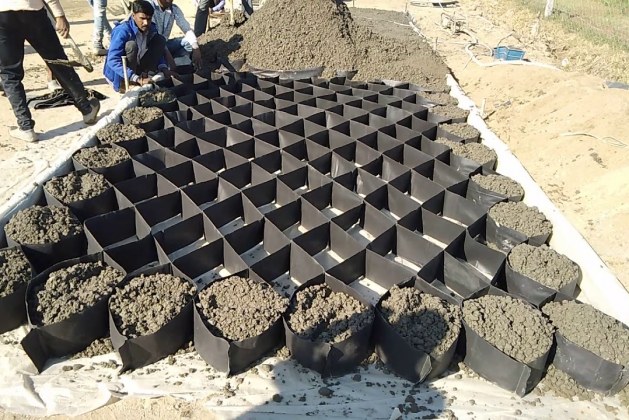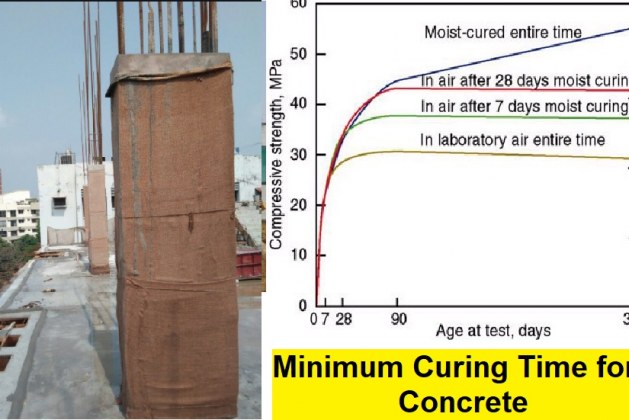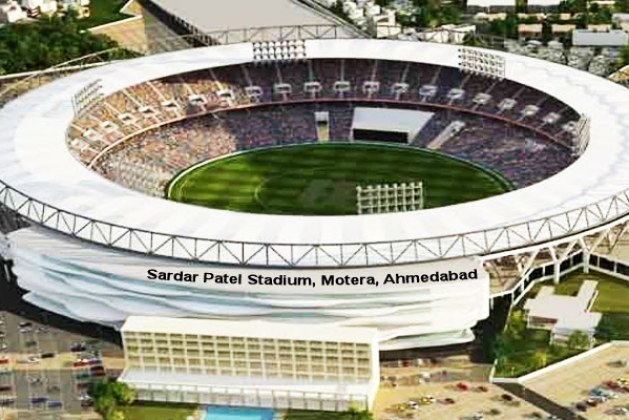Different exposure conditions are established based on the degree of severity of the environmental conditions of the area in which the structure is located. Various codes such as Indian Standard, American Concrete Institute, and European Standard have set similar exposure ...
Concrete Technology
Home/Concrete TechnologyDo you need to remove the ads? Become VIP Member
Category: Concrete Technology
Concrete is a construction material composed of cement, fine aggregates (sand) and coarse aggregates mixed with water which hardens with time. Portland cement is the commonly used type of cement for production of concrete. Concrete technology deals with study of properties of concrete and its practical applications.
In a building construction, concrete is used for the construction of foundations, columns, beams, slabs and other load bearing elements.
There are different types of binding material is used other than cement such as lime for lime concrete and bitumen for asphalt concrete which is used for road construction.
Various types of cements are used for concrete works which have different properties and applications. Some of the type of cement are Portland Pozzolana Cement (PPC), rapid hardening cement, Sulphate resistant cement etc.
Table of Contents
Materials are mixed in specific proportions to obtain the required strength. Strength of mix is specified as M5, M10, M15, M20, M25, M30 etc, where M signifies Mix and 5, 10, 15 etc. as their strength in kN/m2. In United States, concrete strength is specified in PSI which is Pounds per Square Inch.

Water cement ratio plays an important role which influences various properties such as workability, strength and durability. Adequate water cement ratio is required for production of workable concrete.
When water is mixed with materials, cement reacts with water and hydration reaction starts. This reaction helps ingredients to form a hard matrix that binds the materials together into a durable stone-like material.
Concrete can be casted in any shape. Since it is a plastic material in fresh state, various shapes and sizes of forms or formworks are used to provide different shapes such as rectangular, circular etc.
Various structural members such as beams, slabs, footings, columns, lintels etc. are constructed with concrete.
ACI 318 Building code requirements for structural concrete and ACI 301 Specifications for Structural Concrete are used in United States as standard code of practice for concrete construction.
There are different types of admixtures which are used to provide certain properties. Admixtures or additives such as pozzolans or superplasticizers are included in the mixture to improve the physical properties of the wet mix or the finished material.
Various types of concrete are manufactured these days for construction of buildings and structures. These have special properties and features which improve quality of construction as per requirement.
Components of Concrete
Components of concrete are cement, sand, aggregates and water. Mixture of Portland cement and water is called as paste. So, concrete can be called as a mixture of paste, sand and aggregates. Sometimes rocks are used instead of aggregates.
The cement paste coats the surface of the fine and coarse aggregates when mixed thoroughly and binds them. Soon after mixing the components, hydration reaction starts which provides strength and a rock solid concrete is obtained.
What is Grade of Concrete?
Grade of concrete denotes its strength required for construction. For example, M30 grade signifies that compressive strength required for construction is 30MPa. The first letter in grade “M” is the mix and 30 is the required strength in MPa.
Based on various lab tests, grade of concrete is presented in Mix Proportions. For example, for M30 grade, the mix proportion can be 1:1:2, where 1 is the ratio of cement, 1 is the ratio of sand and 2 is the ratio of coarse aggregate based on volume or weight of materials.
The strength is measured with concrete cube or cylinders by civil engineers at construction site. Cube or cylinders are made during casting of structural member and after hardening it is cured for 28 days. Then compressive strength test is conducted to find the strength.
Regular grades of concrete are M15, M20, M25 etc. For plain cement concrete works, generally M15 is used. For reinforced concrete construction minimum M20 grade of concrete are used.
| Concrete Grade | Mix Ratio | Compressive Strength | |
| MPa (N/mm2) | psi | ||
| Normal Grade of Concrete | |||
| M5 | 1 : 5 : 10 | 5 MPa | 725 psi |
| M7.5 | 1 : 4 : 8 | 7.5 MPa | 1087 psi |
| M10 | 1 : 3 : 6 | 10 MPa | 1450 psi |
| M15 | 1 : 2 : 4 | 15 MPa | 2175 psi |
| M20 | 1 : 1.5 : 3 | 20 MPa | 2900 psi |
| Standard Grade of Concrete | |||
| M25 | 1 : 1 : 2 | 25 MPa | 3625 psi |
| M30 | Design Mix | 30 MPa | 4350 psi |
| M35 | Design Mix | 35 MPa | 5075 psi |
| M40 | Design Mix | 40 MPa | 5800 psi |
| M45 | Design Mix | 45 MPa | 6525 psi |
| High Strength Concrete Grades | |||
| M50 | Design Mix | 50 MPa | 7250 psi |
| M55 | Design Mix | 55 MPa | 7975 psi |
| M60 | Design Mix | 60 MPa | 8700 psi |
| M65 | Design Mix | 65 MPa | 9425 psi |
| M70 | Design Mix | 70 MPa | 10150 psi |
How to Make Concrete?
Concrete is manufactured or mixed in proportions w.r.t. cement quantity. There are two types of concrete mixes, i.e. nominal mix and design mix. Nominal mix is used for normal construction works such as small residential buildings. Most popular nominal mix are in the proportion of 1:2:4.
Design mixed concrete are those for which mix proportions are finalized based on various lab tests on cylinder or cube for its compressive strength. This process is also called as mix design. These tests are conducted to find suitable mix based on locally available material to obtain strength required as per structural design. A design mixed offers economy on use of ingredients.
Once suitable mix proportions are known, then its ingredients are mixed in the ratio as selected. Two methods are used for mixing, i.e. Hand Mixing or Machine Mixing.
Based on quantity and quality required, the suitable method of mixing is selected. In the hand mixing, each ingredients are placed on a flat surface and water is added and mixed with hand tools. In machine mixing, different types of machines are used. In this case, the ingredients are added in required quantity to mix and produce fresh concrete.
Once the it is mixed adequately it is transported to casting location and poured in formworks. Various types of formworks are available which as selected based on usage.
Poured concrete is allowed to set in formworks for specified time based on type of structural member to gain sufficient strength.
After removal of formwork, curing is done by various methods to make up the moisture loss due to evaporation. Hydration reaction requires moisture which is responsible for setting and strength gain. So, curing is generally continued for minimum 7 days after removal of formwork.
Types of Concrete Construction
Concrete is generally used in two types of construction, i.e. plain concrete construction and reinforced concrete construction. In PCC, it is poured and casted without use of any reinforcement. This is used when the structural member is subjected only to the compressive forces and not bending.
When a structural member is subjected to bending, reinforcements are required to withstand tension forces structural member as it is very weak in tension compared to compression. Generally, strength of concrete in tension is only 10% of its strength in compression.
It is used as a construction material for almost all types of structures such as residential concrete buildings, industrial structures, dams, roads, tunnels, multi storey buildings, skyscrapers, bridges, sidewalks and superhighways etc.
Example of famous and large structures made with concrete are Hoover Dam, Panama Canal and Roman Pantheon. It is the largest human made building materials used for construction.
Steps of Concrete Construction
The construction steps are:
- Selecting quantities of materials for selected mix proportion
- Mixing
- Checking of workability
- Transportation
- Pouring in formwork for casting
- Vibrating for proper compaction
- Removal of formwork after suitable time
- Curing member with suitable methods and required time.
Discy Latest Articles
Cell filled Concrete Pavement – Components, Procedure, and Advantages

Cell-filled concrete pavement is the technology developed by IIT Kharagpur, which has proved to be a very promising solution for overloaded vehicles, inadequate drainage facilities, and waterlogging problems. Cell-filled concrete pavement consists of formwork of plastic cells over the compacted ...
What is the Minimum Curing Period for Concrete?

The minimum curing period for concrete is controlled by the type of cement used, ambient temperature, type of construction (size and shape of concrete member), designated strength, and curing regime. For the majority of concrete structures, the minimum curing period ...
Narendra Modi Stadium: Construction Features of the Largest Cricket Stadium in the World

Sardar Patel Stadium was renamed as Narendra Modi Stadium on 24th February 2021, also known as Motera Stadium. The cricket stadium is located in the state of Gujarat in India. It is situated on the banks of the Sabarmati river ...
4 Types of Cracks in Concrete Columns and their Causes: Video Included
Four types of cracks developed in reinforced concrete column are diagonal cracks, horizontal cracks, splitting cracks, corrosion cracks. The causes of cracks in columns can be incorrect design, faulty construction or overloading, corrosion of reinforcement, isolated settlement of foundations, creep ...
Major Problems in Concrete Pumping Works: How to Avoid Them? Video Included
The major problems that one encounters when pumping concrete are blockage of pipeline, and segregation and bleeding of concrete mix. Blockage is the failure of concrete to emerge at the end of the pipeline. It is characterized by an increase ...
What are the Causes of Cracks in Reinforced Concrete Slab? Video Included
Several factors like poor concrete quality, improper structural design, inappropriate steel bar spacing, large slab span, improper aggregates, etc. are responsible for the development of cracks in RCC slabs. While the issues pertaining to improper structural design can be eliminated ...
How to Prevent Honeycomb in Concrete Structures? Video Included
The prevention of honeycomb in concrete structures can save time and money, and help construct structurally sound concrete members. Therefore, undertaking preventive measures to avoid the occurrence of honeycomb is of utmost importance. The measures include proper compaction, use of ...
